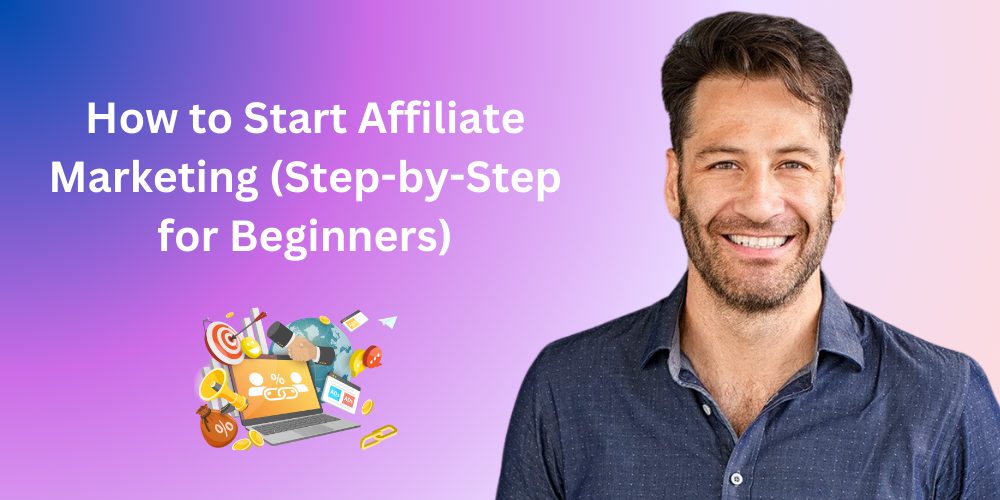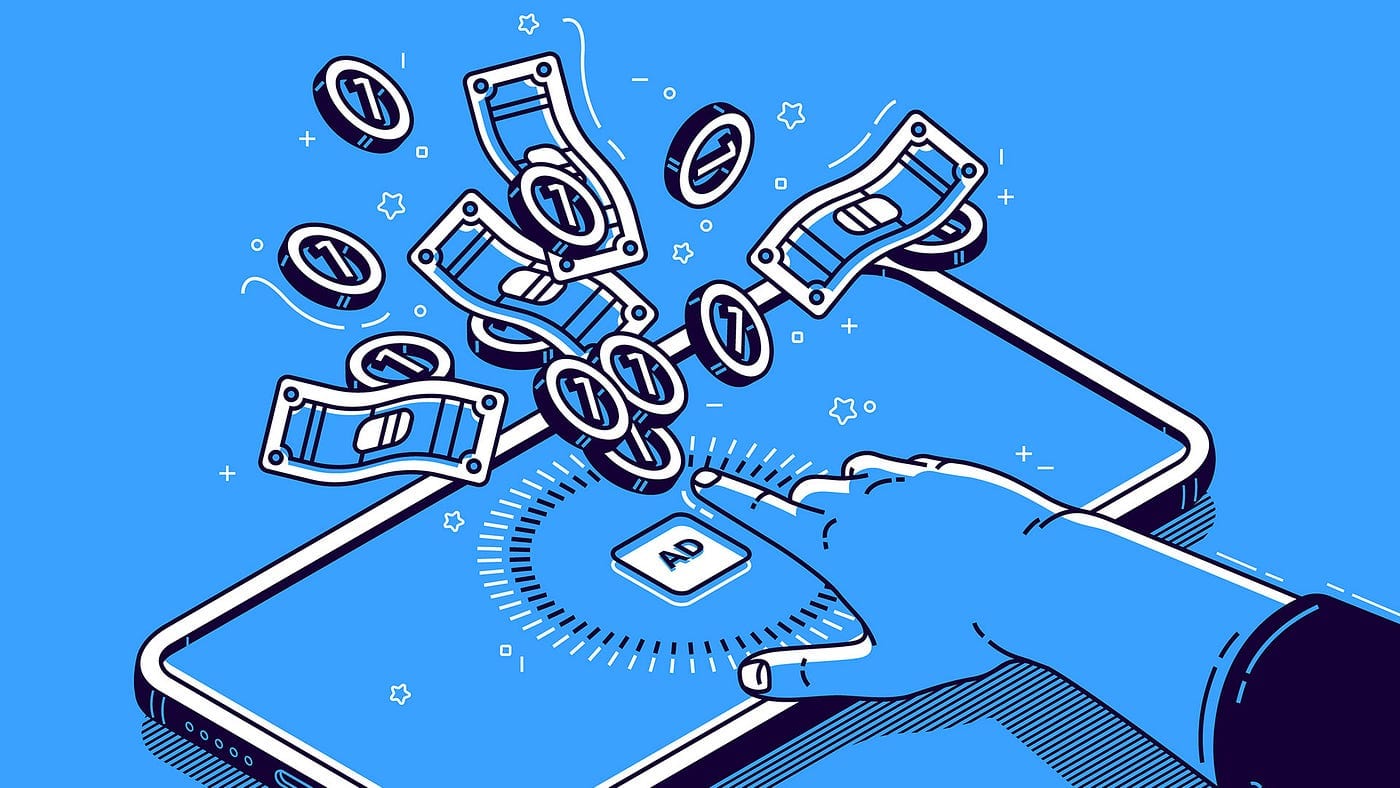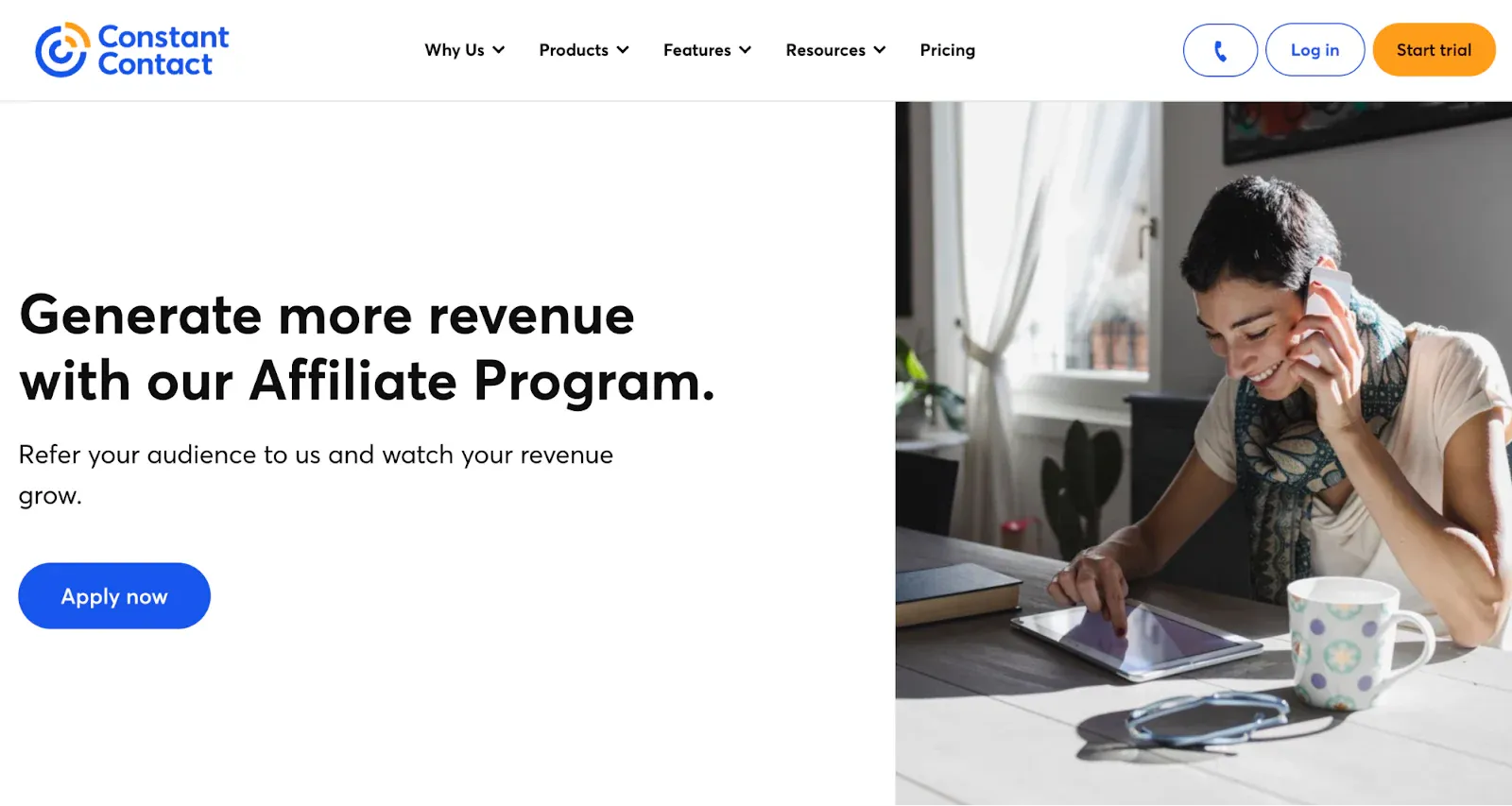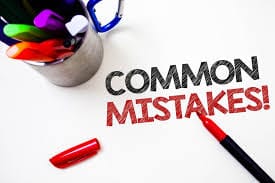How to Start Affiliate Marketing (Step-by-Step for Beginners)

Affiliate marketing is like recommending your favourite pizza spot to friends, except you get paid every time they grab a slice. Pretty sweet deal, right? And the best part is you don't need to make or stock the pizza yourself.
But if you're new to this whole "making money while sleeping" thing, don’t sweat it. This guide has everything you need to start raking in commissions.
What Is Affiliate Marketing?
Simply put, affiliate marketing means earning a commission by promoting other people's products or services. You share a special link on your blog, social media, or videos. If someone clicks that link and buys, you earn money. It's like magic, but with more clicking.
Ever googled "best running shoes" and landed on a site full of Amazon links? Those are affiliate marketers in action. Each sale earns them a tasty cut.
How Does Affiliate Marketing Work?
Here's the simple breakdown:
- Merchant: Company selling the product.
- Affiliate Program/Network: Platform like Amazon Affiliates or ShareASale that tracks sales.
- Affiliate (you!): The cool kid who promotes and gets paid.
You promote links or banners, people click, buy stuff, and voilà—you earn a commission. Just don’t forget: cookies track these clicks. If a visitor clears their cookies or delays buying, no commission for you. So encourage quick clicks (without sounding desperate, of course).
The Two Big Ways Affiliate Marketers Get Paid

Alright, affiliate payouts usually happen through two main commission models:
1. Pay-Per-Sale (PPS): Cha-Ching When They Buy
This one’s the classic. You promote a product or service, someone clicks your link, makes a purchase, and boom—you get paid a slice of the sale.
Typical commissions range from 5% to 50%, depending on the niche and the offer. Some programs pay even higher (looking at you, high-ticket SaaS deals 👀).
💡 Example: As a Leadplay.io affiliate partner, you can earn up to 35% recurring commissions. That’s every month your referral keeps using the platform—hello, passive income party.
Other programs might pay a flat rate, like $10, $25, or even $100 per sale, especially for services and software.
2. Pay-Per-Lead (PPL): Get Paid for Generating Interest
Here, you don’t even need the person to buy—just get them to sign up, book a call, or drop their email in a form.
These leads are gold for businesses, so they’ll gladly pay you for them. Depending on the niche, PPL commissions can range from $1 to $50+ per lead.
Why Bother With Affiliate Marketing? 7 No-Brainer Reasons

Affiliate marketing isn’t just for influencers with ring lights and perfect morning routines. It’s a smart, low-risk way to monetize your content—even if you’re starting from scratch.
1. No Product? No Problem!
You don’t need to invent the next iPhone or stockpile scented candles in your garage. With affiliate marketing, you skip the manufacturing drama, shipping headaches, and angry return requests. Your job? Share links and get paid when people click and buy. Simple.
2. Freedom to Promote Anything
Whether you're obsessed with ergonomic office chairs or that weird productivity app no one’s heard of—go for it. You can promote what you love or what converts best (hello, high commissions). There’s a niche for everything, and you get to pick your playground.
3. Make Money While You Snooze

Ever dreamed of waking up to money in your account without lifting a finger overnight? Affiliate marketing makes that dream a little less “fairy tale” and a lot more “actual strategy.” Create evergreen content once, and it keeps earning—while you're binge-watching or drooling on your pillow.
4. Low Costs, High Returns
You don’t need a warehouse or a Silicon Valley investor. Just a laptop, a decent internet connection, and something valuable to say. Compared to starting a traditional business, affiliate marketing is like entering a race with rocket-powered roller skates—on a budget.
5. Traffic? Less is More
No need for millions of views or viral fame. A small, loyal audience that trusts your recommendations can be incredibly profitable. Quality > quantity—and niche communities convert better than general crowds anyway.
6. Flexibility on Steroids
Side hustle? Full-time gig? You choose. Affiliate marketing scales as you grow—whether you're writing blog posts from your kitchen table or building a media empire. Just look at Wirecutter, the review site that turned product recommendations into millions.
7. Credibility Boost

Promote the right products, and your audience sees you as a helpful guide—not a salesperson. Every great recommendation strengthens your brand, builds trust, and keeps people coming back (and clicking). Win-win.
Types of Affiliate Marketing Channels
Affiliate marketing doesn't have to be complicated. In fact, it can be pretty fun. Let's talk about the top channels you can use to sell products and earn some cash—without boring yourself or your audience to death.
1. Paid Traffic 💸

Paid traffic means running ads on platforms like Google, Facebook, LinkedIn, or even TikTok. It's fast, effective, but careful! Some brands don't let affiliates run ads (spoilsports!). If they do, always use deep linking—sending users straight to the offer’s landing page, not just the homepage. Nobody wants to hunt around for what they clicked on.
2. Content-Rich Blogs and Websites 📝
This is the crowd favourite—free and (almost) effortless! Create great content around a specific niche, optimize it for SEO, and watch Google send you steady traffic. Once your blog gains authority, you can effortlessly slip in affiliate links and start making some passive income. It's like magic—but with keywords instead of wands.
3. Social Media 📱

Everyone’s hanging out on social media, and so should your affiliate offers. Facebook, Instagram, Pinterest, or even Twitter (X)—just make sure you follow the rules because some brands get grumpy about affiliates on social media. Create genuine posts showing how the product can solve a problem or make life easier. A quick video or a funny meme can go a long way.
4. Email Marketing 📧

Your email list is gold—treat it that way. Capture emails with handy lead magnets (think free eBooks or checklists). Then send regular, useful newsletters sprinkled with your affiliate links. Pro tip: Set up automated emails to build trust over time. It's like dating your subscribers before popping the "buy this" question.
5. Video Marketing 🎬

Videos are your best friend in affiliate marketing. Create YouTube reviews, demos, or tutorials to showcase products. People love seeing how stuff works before buying. It's a bit like window shopping but online. Plus, videos tend to boost conversions significantly—everyone trusts the person brave enough to go on camera.
6. Forum Marketing 🗣️
Forums might sound old-school, but they're still buzzing with potential buyers. Be active, genuinely helpful, and subtly drop your links in your signature. Don't spam—no one likes a spammer (especially moderators). Keep it classy and useful.
How to Pick the Right Affiliate Marketing Strategy
Choosing the right strategy depends on what you want to achieve. Want more subscribers? Go heavy on email marketing. Need quick sales? Paid ads and video reviews can work wonders. Pick channels matching your goals—then experiment and find your sweet spot.
Before diving in, remember:
- Affiliate marketing isn't instant; patience is key.
- Always test and tweak your strategies.
- Only promote stuff you trust (bad reviews haunt forever).
- Keep tracking your results; analytics are your friend.
- Keep optimizing and improving your game.
7-Step Guide for Affiliate Marketing Beginners

Feeling overwhelmed? Don’t worry—we’ve broken down affiliate marketing into bite-sized, beginner-friendly steps to get you earning without the guesswork.
Step 1: Choose Your Niche
Pick something you actually like. Whether it’s cooking, gaming, fitness, or tech—if you’re bored, your audience will notice. Also, decide how you'll create content: blogs, podcasts, or YouTube?
Step 2: Create Amazing Content
Know your audience, solve their problems, and keep them entertained. Be consistent, and promote your content everywhere—yes, even that random subreddit you love.
Step 3: Join Affiliate Networks
Once you have a decent following, sign up for networks like Amazon Associates, Clickbank, CJ Affiliate, ShareASale, or Impact. And yes, leadplay.io has a pretty good program for B2B and LinkedIn marketing, wink-wink.
Step 4: Pick Products Worth Promoting
Promote products you'd recommend to friends. Make sure they’re genuinely useful, pay well, and have generous cookie durations. Reviews never lie (usually).
Step 5: Promote Like Crazy (But Not Too Crazy)
Create more content around your offers, sprinkle affiliate links wisely, run ads, and send persuasive yet friendly emails.
Step 6: Optimize for Conversions
Clear call-to-actions and relevant affiliate links are your friends. Just don't be pushy—no one likes that guy.
Step 7: Track, Earn, and Repeat
Check your analytics regularly (leadplay gives you handy built-in reports). Track which channels perform best, then double down.
Affiliate Marketing Made Easy: 10 Tips for Making Real Money

Some affiliate marketers make enough to retire to a sunny beach; others just earn enough for coffee. But let's face it—earning a decent income from affiliate marketing isn’t rocket science. Here are ten simple, effective tips to boost your affiliate game (without selling your soul or spamming your friends).
1. Pick a Niche You Actually Care About
Sure, you could write about vacuum cleaners. But if you don't even vacuum your own home, good luck convincing others to buy one. Find something you genuinely enjoy, like gaming, fitness, or sustainable fashion. It’s way easier—and less painful—to create engaging content when you actually care.
2. Know Your Products Inside Out
Promoting stuff you don’t understand is like selling ice cream to Eskimos—pointless and awkward. Take time to research the products you're promoting. Read reviews, test products if possible, and genuinely understand their value.
3. Choose Affiliate Programs Wisely

Not all affiliate programs are equal. Check commission rates (hint: anything above 20% is sweet), look for recurring commissions, and ensure their payout system doesn't require decoding hieroglyphics. Platforms like leadplay.io are popular because they make life easy, not harder.
4. Create Content Worth Reading (or Watching!)
Nobody clicks on boring stuff. Create blogs, videos, or infographics that entertain, inform, or solve problems. Imagine you’re talking to a mate over drinks—be helpful, honest, and yes, a bit funny.
5. Get Visible Online (Without Being Annoying)
Set up a simple website, get social media profiles going, and engage with your community. Guest post occasionally, but don’t spam links everywhere—unless you love being ignored or blocked.
6. Use Smart Marketing Tactics

Learn basic SEO, run targeted social media ads, and send useful email newsletters. Experiment to find out what your audience actually clicks. Google Analytics and tools like Ahrefs will be your new best friends.
7. Sweeten the Deal With Freebies and Discounts

Everyone loves a bargain. Offer exclusive discount codes or freebies. A small discount code can turn hesitant browsers into enthusiastic buyers (and you into their favourite marketer).
8. Track Your Success
Don't fly blind—track your traffic, clicks, and sales. Knowing what works (and what flops miserably) helps you double down on your strengths and ditch your duds.
9. Make a Plan (Yes, Actually Write One)
Affiliate marketing without a plan is like wandering through IKEA without a map—confusing, exhausting, and you’ll probably leave empty-handed. Set clear goals, define your audience, and monitor your budget and progress regularly.
10. Be Patient (Seriously)
Rome wasn't built overnight, and neither is your affiliate empire. Patience and consistency are your superpowers. Keep creating good stuff, promoting wisely, and don't get discouraged when you’re not a millionaire by next Tuesday.
Why Join the Leadplay Affiliate Program?

Leadplay.io is an easy-to-use sales automation tool that's popular for LinkedIn outreach. Joining their affiliate program gives you:
- Up to 35% commission on initial sales
- 20% recurring commission (free money, basically)
- Easy-to-use affiliate dashboard
- Tons of ready-to-go marketing materials
- Fast payouts directly to your PayPal
Just fill out the form, grab your unique link, and you're good to go. Share it through email, social media, or paid ads—however you like.
Common Affiliate Marketing Mistakes To Avoid

Even seasoned marketers slip up, but knowing what not to do can save you time, money, and your sanity. Here are the top rookie mistakes that can quietly sabotage your affiliate success—and how to dodge them like a pro.
1. Not Researching Properly
Flying blind never ends well. Before promoting anything, take time to understand your audience, your niche, and what actually sells. The more you know, the better your chances of hitting the sweet spot between helpful and profitable.
2. Ignoring Your Email List
Your email list is pure gold—seriously. It’s the one place you own your audience, free from algorithm chaos. Start building it early and treat it like the VIP section of your strategy.
3. Offering No Value
Affiliate marketing isn’t about dropping links and praying for clicks. You need to be useful. Share insights, solve problems, and explain why a product is worth it. No value = no trust = no sales.
4. Getting Impatient
Affiliate income isn’t instant ramen—it’s a slow-cooked stew. Expect to test, tweak, and wait. Stay consistent, keep showing up, and the results will follow (promise).
5. Promoting Random Products
Chasing high commissions with totally unrelated products is a one-way ticket to confusion and lost trust. Stick to what fits your niche and serves your audience. Relevance is what makes people click—and buy.
Affiliate vs. Referral Marketing: What's the Difference?

Referral marketing rewards existing customers for bringing in friends (think Uber's "invite a friend").
Affiliate marketing pays third-party marketers for generating sales through their channels.
Affiliates love the transparency (you know exactly how much you’re earning), while referrals work best when you've already got happy customers spreading the love.
Ready to Start?
Affiliate marketing is a brilliant side hustle (or even a main gig). It doesn't require massive startup costs—just your laptop, internet, and some hustle. And who knows? Maybe one day soon, you'll trade your daily grind for a beach somewhere warm. No vacuum sales required.